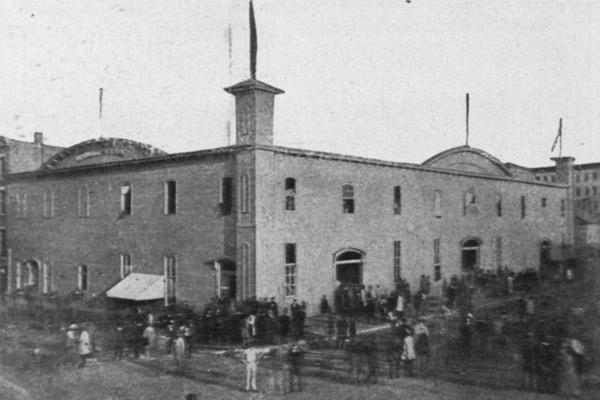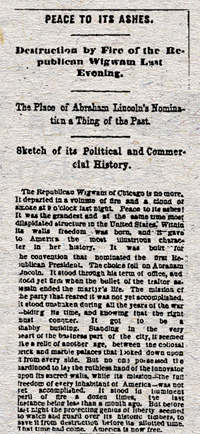
The Wigwam, shot by the famous Chicago photographer Alexander Hesler; he also took pictures of Lincoln before he became president, including this one.
What happened to Chicago’s Wigwam?
HISTORY This month marks the 150th anniversary of Abraham Lincoln winning the Republican nomination for president here in Chicago. That momentous event occurred on May 18, 1860, inside a large, two-story, pine-plank convention hall at what is today the southeast corner of Lake Street and Wacker Drive. Like other political gathering places in its day, the hastily built hall was known as the Wigwam.
 |
Everybody knows what became of Lincoln (who wasn’t in Chicago for the convention), but what happened to the Wigwam? The Encyclopedia of Chicago alludes only to its “removal sometime between 1867 and 1871.” The Abraham Lincoln Historical Digitization Project, based at Northern Illinois University, says that the building “burned down, perhaps in the Great Chicago Fire of 1871.” While both reports aren’t entirely wrong, neither are they right. Here’s exactly what happened.
“The Republican Wigwam of Chicago is no more,” lamented the Chicago Tribune on Sunday, November 14, 1869 (the Tribune reprinted the article on Monday, November 15th; shown right). “It departed in a volume of fire and a cloud of smoke at 9 o’clock last night. Peace to its ashes!” The article characterized the old wooden building as the “grandest and at the same time most dilapidated structure in the United States.” It then went on to describe the building’s construction, as well as its post-convention uses as a site of pro-Union rallies, as a billet for Federal soldiers, and, finally, as an early urban mall containing 17 stores. Along the way the story provided some insights into Chicago circa 1869, particularly regarding the frequent fires that plagued the city; the unnamed reporter noted that the Wigwam had been threatened by fire more than a dozen times, “the last instance being less than a month ago.”
The most dramatic passages of the article depicted the fire itself. Dense black clouds of smoke obscured the moon, while at the same time “angry flames” illuminated the nearby streets. “In the distance,” reported the Tribune, “it would seem as if a whole section of the city was burning.” As news of the conflagration spread, crowds of people rushed from the opera, the theatres, and the saloons and surrounded the building—“one of the very few historic landmarks” in Chicago—which was soon reduced to “blackened beams, crisped rafters, and charred cinders.”
GOOD, RELATED LINKS:
- Writing last week in the Chicago Tribune, the historian Richard Norton Smith, the founding director of the Abraham Lincoln Presidential Library and Museum in Springfield, insisted that Lincoln’s nomination “owe[d] less to the hand of providence than [to] a Chicago fix. . . . The survival of the Union, and the new birth of freedom that brought immortality to America’s 16th president, had been sealed by the most classic of Chicago political devices, a wink and a nod.”
- In a May 18, 2010 editorial, the Tribune took pride in its occasionally “unscrupulous” role in helping Lincoln secure the nomination. “Lincoln had Chicago’s political muscle—and its finest mischief-makers—behind him. Including [Tribune managing editor and co-owner Joseph] Medill, of course.”
- A plaque in front of 191 North Wacker, the building that occupies the site of the Wigwam, notes that the corner of Lake and Wacker was also the location of the Sauganash Hotel. Built by Mark Beaubien around 1830, the hospitable inn served as an early civic center—the town’s first trustees were elected there in 1833—and as the city’s first theatre. The Sauganash burned down in 1851.
Photograph by Alexander Hesler


